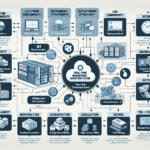Optimizing IT infrastructure for Kafka-based real-time data streaming involves careful planning, configuration, and resource allocation to ensure high performance, scalability, reliability, and fault tolerance. Below are key considerations and strategies to optimize your infrastructure for Kafka:
1. Design a Robust Kafka Cluster Architecture
- Cluster Size and Brokers:
- Determine the number of brokers based on expected throughput and scalability needs. Kafka scales horizontally, so add more brokers as traffic grows.
-
Use an odd number of brokers for proper leader election with Zookeeper.
-
Replication Factor:
-
Set an appropriate replication factor for topics to ensure fault tolerance. A minimum of 3 replicas is recommended.
-
Partitions:
- Optimize the number of partitions to balance load across brokers and improve parallelism. More partitions allow higher throughput but increase metadata overhead.
2. Infrastructure Resources
- Compute:
- Deploy Kafka brokers on machines with high-performance CPUs to handle message serialization/deserialization and network traffic efficiently.
-
Ensure adequate CPU allocation for producers and consumers in your streaming architecture.
-
Memory:
-
Kafka relies heavily on memory for caching. Ensure brokers have sufficient RAM to handle large volumes of data. A general recommendation is to allocate 50-70% of available system memory to Kafka heap and leave the rest for file system caching.
-
Storage:
- Use fast SSDs for Kafka logs to improve I/O performance and reduce latency.
-
Monitor disk usage closely and plan for sufficient disk capacity to store data based on retention policies.
-
Network:
- Provision high-bandwidth, low-latency network interfaces for Kafka brokers to handle large volumes of data efficiently.
- Consider dedicated network links for inter-broker replication and producer-consumer traffic.
3. Optimize Kafka Configuration
- Broker Settings:
- Tune
num.network.threads,num.io.threads, andlog.segment.bytesbased on workload. -
Use compression (e.g., Snappy or LZ4) for message payloads to reduce network bandwidth usage.
-
Retention Policies:
-
Configure topic-specific retention policies (
retention.msandretention.bytes) based on business requirements to avoid excessive storage consumption. -
Replication and Acknowledgment:
- Use
acks=allfor producers to ensure data durability. -
Monitor and adjust
min.insync.replicasfor fault tolerance. -
Zookeeper:
- Optimize Zookeeper configuration for leader election and metadata management. Ensure Zookeeper nodes have fast disks and sufficient memory.
4. Virtualization and Kubernetes
- Bare Metal vs Virtualization:
- Deploy Kafka on bare-metal servers for maximum performance, or use virtualization/Kubernetes if flexibility and scalability are priorities.
-
For Kubernetes, use StatefulSets for Kafka brokers and persistent volumes for storage.
-
Resource Requests and Limits:
- In Kubernetes, define resource requests and limits for Kafka pods to prevent resource contention.
5. Monitoring and Alerting
- Monitoring Tools:
- Use tools like Prometheus, Grafana, or Kafka Manager to monitor broker health, topic metrics, partition distribution, and consumer lag.
-
Monitor disk usage, CPU, memory, and I/O throughput.
-
Alerting:
- Set up alerts for critical metrics like consumer lag, high disk usage, or broker failure.
6. Backup and Disaster Recovery
- Backup Strategies:
- Implement a backup solution for Kafka logs using tools like Apache MirrorMaker or custom scripts.
-
Regularly backup Zookeeper metadata for recovery.
-
Replication Across Datacenters:
- Use Kafka’s built-in cross-cluster replication features to replicate data across datacenters for disaster recovery.
7. Security
- Authentication and Authorization:
- Enable SSL/TLS for secure communication between producers, consumers, and brokers.
-
Use SASL (Simple Authentication and Security Layer) for authentication.
-
Access Control:
- Implement fine-grained ACLs (Access Control Lists) for topic-level access control.
8. AI and Predictive Analytics
- Proactive Scaling:
- Use AI-driven analytics to predict traffic spikes and proactively scale Kafka brokers or infrastructure components.
- Deploy machine learning models to detect anomalies in Kafka metrics for early fault detection.
9. GPU Utilization for Real-Time Analytics
- Integration with AI Workloads:
- If Kafka streams are being used for real-time AI inference, deploy GPU-enabled servers to process data streams efficiently.
- Use frameworks like TensorFlow Serving or Triton Inference Server to process Kafka streams in real time.
10. Testing and Benchmarking
- Performance Testing:
- Use tools like Apache JMeter or Kafka benchmarking tools to simulate load and identify bottlenecks.
-
Test producer/consumer throughput and latency under various scenarios.
-
Chaos Engineering:
- Implement chaos testing using tools like Chaos Monkey or Litmus to ensure resilience under failure conditions.
By applying these optimizations, you can ensure your Kafka-based real-time data streaming infrastructure is well-tuned for performance, scalability, and reliability.



